The AMD Zen and Ryzen 7 Review: A Deep Dive on 1800X, 1700X and 1700
by Ian Cutress on March 2, 2017 9:00 AM ESTBenchmarking Performance: CPU Rendering Tests
Rendering tests are a long-time favorite of reviewers and benchmarkers, as the code used by rendering packages is usually highly optimized to squeeze every little bit of performance out. Sometimes rendering programs end up being heavily memory dependent as well - when you have that many threads flying about with a ton of data, having low latency memory can be key to everything. Here we take a few of the usual rendering packages under Windows 10, as well as a few new interesting benchmarks.
Corona 1.3
Corona is a standalone package designed to assist software like 3ds Max and Maya with photorealism via ray tracing. It's simple - shoot rays, get pixels. OK, it's more complicated than that, but the benchmark renders a fixed scene six times and offers results in terms of time and rays per second. The official benchmark tables list user submitted results in terms of time, however I feel rays per second is a better metric (in general, scores where higher is better seem to be easier to explain anyway). Corona likes to pile on the threads, so the results end up being very staggered based on thread count.
Blender 2.78
For a render that has been around for what seems like ages, Blender is still a highly popular tool. We managed to wrap up a standard workload into the February 5 nightly build of Blender and measure the time it takes to render the first frame of the scene. Being one of the bigger open source tools out there, it means both AMD and Intel work actively to help improve the codebase, for better or for worse on their own/each other's microarchitecture.
LuxMark
As a synthetic, LuxMark might come across as somewhat arbitrary as a renderer, given that it's mainly used to test GPUs, but it does offer both an OpenCL and a standard C++ mode. In this instance, aside from seeing the comparison in each coding mode for cores and IPC, we also get to see the difference in performance moving from a C++ based code-stack to an OpenCL one with a CPU as the main host.
POV-Ray 3.7
Another regular benchmark in most suites, POV-Ray is another ray-tracer but has been around for many years. It just so happens that during the run up to AMD's Ryzen launch, the code base started to get active again with developers making changes to the code and pushing out updates. Our version and benchmarking started just before that was happening, but given time we will see where the POV-Ray code ends up and adjust in due course.
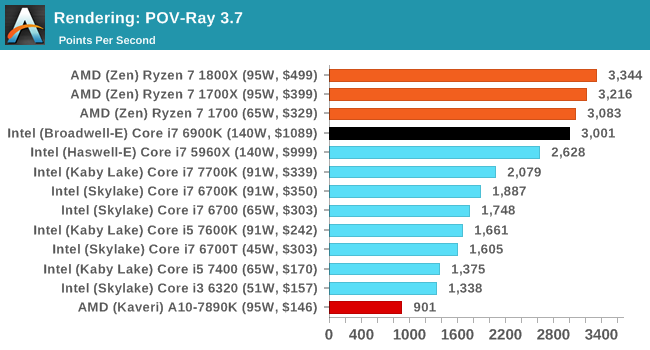
Cinebench R15
The latest version of CineBench has also become one of those 'used everywhere' benchmarks, particularly as an indicator of single thread performance. High IPC and high frequency gives performance in ST, whereas having good scaling and many cores is where the MT test wins out.
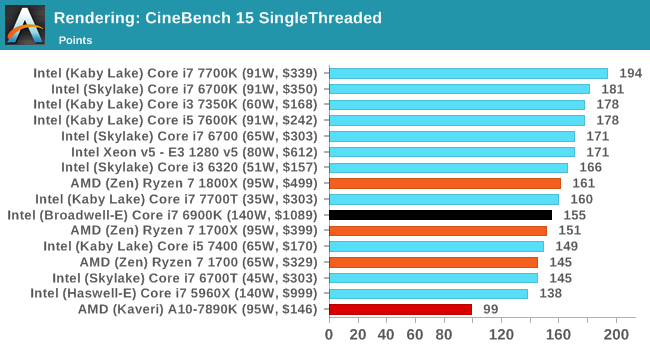
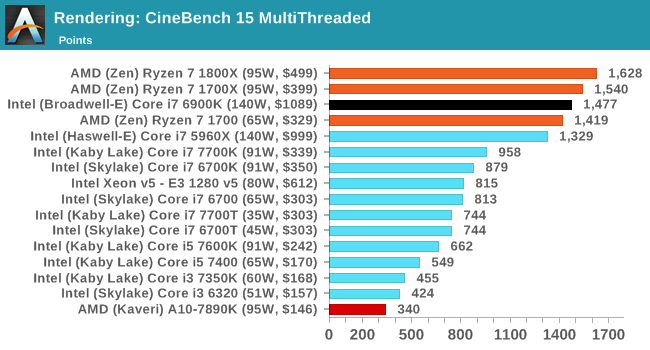


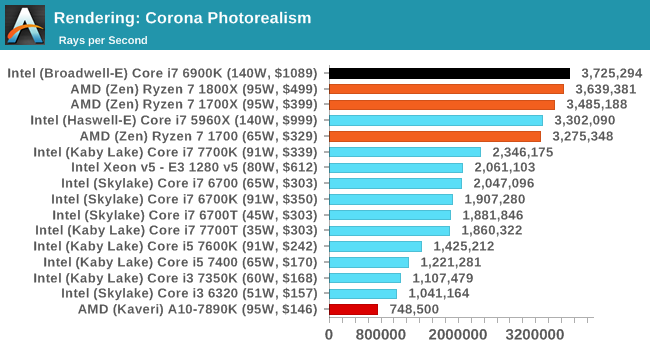
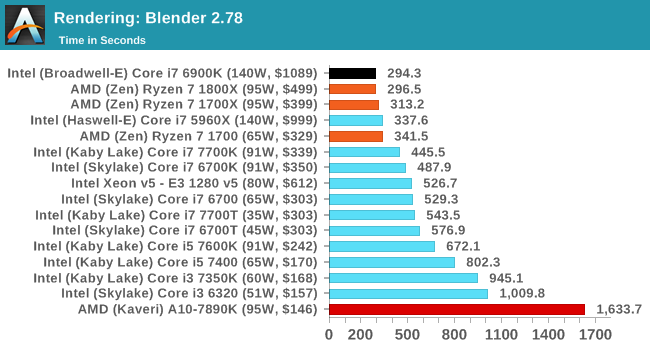

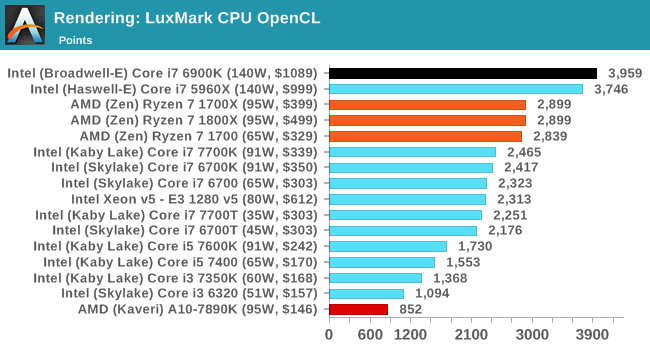








574 Comments
View All Comments
deltaFx2 - Wednesday, March 8, 2017 - link
@Meteor2: No. Consumer GPUs have poor throughput for Double precision FP. So you can't push those to the GPU (unless you own those super-expensive Nvidia compute cards). Apparently, many rendering/video editing programs use GPUs for preview but do the final rendering on CPU. Quality, apparently, and might be related to DP FP. I'm not the expert, so if you know otherwise, I'd be happy to be corrected and educated. Also, you could make the same argument about AVX-256.The quoted paragraph is probably the only balanced statement in that entire review. Compare the tone of that review with AT review above.
On an unrelated note, there's the larger question of running games at low res on top-end gpus and comparing frame-rates that far exceed human perception. I know, they have to do something, so why not just do this. The rationale is: " In future a faster GPU in future will create a bottleneck ". If this is true, it should be easy to demonstrate, right? Just dig through a history of Intel desktop CPUs paired with increasingly powerful GPUs and see how it trends. There's not one reviewer that has proven that this is true. It's being taken as gospel. OTOH, plenty of folks seem happy with their Sandy Bridge + Nvidia 1080, so clearly the bottleneck isn't here 5 years after SB. Maybe, just maybe, it's because the differences are imperceptible?
Ryzen clearly has some bottlenecks but the whole gaming thing is a tempest in a tea-cup.
theuglyman0war - Thursday, March 9, 2017 - link
ZBRUSHprobably 90% of all 3d assets that are created from concept ( NOT SCANNED )
Went through Zbrush at some point.
Which means no GPU acceleration at all.
Renderman
Maxwell
Vray
Arnold
still all use CPU rendering As do a mountain of other renderers.
Arnold will be getting an option
But the two popular GPU renderers are Otoy Octane and Redshift...
The have their excellent expensive place. But the majority of rendering out there is still suffered through software rendering. And will always be a valid concern as long as they come FREE built into major DCC applications.
theuglyman0war - Thursday, March 9, 2017 - link
Saw that same GPU trumps CPU render validity concerns...Comment and had a good laugh.
I'll remember to spread that around every time I see Renderman Vray Arnold Maxwell sans GPU rendering going on.
Or the next time a Mercury engine update negates all non Quadro GPU acceleration.
To be fair a lot of creative pros and tech artists seem to disagree with me but...
The only time between pulling vrts in Maya and brushing a surface in Zbrush that I really feel that I am suffering buckets of tears and desire a new CPU ( still on i7-980x ) is when I am cussing out a progress bar that is teasing me with it's slow progress. And that means CORES! encoding... un compressing... Rendering! Otherwise I could probably not notice day to day on a ten year old CPU. ( excluding CPU bound gaming of course... talking bout day to day vrt pulling )
I was just as productive in 2007 as I am today.
MaidoMaido - Saturday, March 4, 2017 - link
Been trying to find a review including practical benchmarks for common video editing / motion graphics applications like After Effects, Resolve, Fusion, Premiere, Element 3D.In a lot of these tasks, the multithreading is not always the best, as a result quad core 6700K often outperforms the more expensive Xeon and 5960X etc
deltaFx2 - Saturday, March 4, 2017 - link
I would recommend this response to the GamersNexus hit piece: https://www.reddit.com/r/Amd/comments/5xgonu/analy...The i5 level performance is a lie.
Notmyusualid - Saturday, March 4, 2017 - link
@ deltaFx2Sorry, not reading a 4k worded response. I'll wait for Anand to finish its Ryzen reviews before I draw any final conclusions.
Meteor2 - Tuesday, March 7, 2017 - link
@deltaFX2 RE: in the 4k word Reddit 'rebuttal', what that person seems to be saying, is that once you've converted your $500 Ryzen 1800X into a 8C/8T chip, _then_ it beats a $240 i5, while still falling short of the $330 i7. Out-of-the-box, it has worse gaming performance than either Intel chip.That's not exactly a ringing endorsement.
The analysis in the Anandtech forums, which concludes that in a certain narrow and low power band a heavily down-clocked 1800X happens to get excellent performance/W, isn't exactly thrilling either.
deltaFx2 - Wednesday, March 8, 2017 - link
@ Meteor2: The anandtech forum thing: Perf/watt matters for servers and laptop. Take a look at the IPC numbers too. His average is that Zen == Broadwell IPC, and ~10% behind Sky/Kaby lake (except for AVX256 workloads). That's not too shabby at all for a $300 part.You completely missed the point of the reddit rebuttal. The GN reviewer drops i5s from plenty of tests citing "methodological reasons", but then says R7==i5 in gaming. The argument is that plenty of games use >4 threads and that puts i5 at a disadvantage.
tankNZ - Sunday, March 5, 2017 - link
yes I agree, it's even better than okay for gaming[img]http://smsh.me/li3a.png[/img]deltaFx2 - Monday, March 6, 2017 - link
You may wish to see this though: https://forums.anandtech.com/threads/ryzen-strictl... Way, way, more detailed than any tech media review site can hope to get. No, it's got nothing to do with gaming. Gaming isn't the story here. AMD's current situation in x86 market share had little to do with gaming efficiency, but perf/watt.I'll quote the author: "850 points in Cinebench 15 at 30W is quite telling. Or not telling, but absolutely massive. Zeppelin can reach absolutely monstrous and unseen levels of efficiency, as long as it operates within its ideal frequency range."